I was looking through some of my old negative scans and found four photos of St Paul’s Cathedral dating from 1977. Nothing special about the photos, and the cathedral is one of the buildings in the City that has not changed, however they did highlight how much dirt the cathedral had accumulated, and in comparison, how clean it looks today.
The following photo shows the view of the cathedral from the junction of Cannon Street and New Change in 1977:
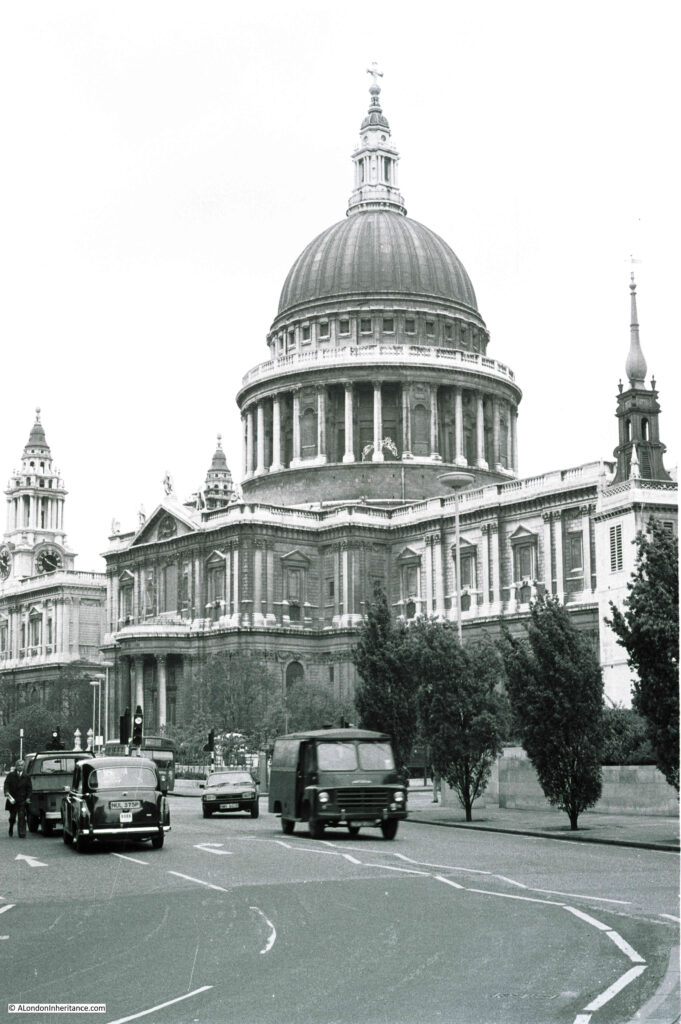
The following photo shows the same view, forty four years later in 2021::
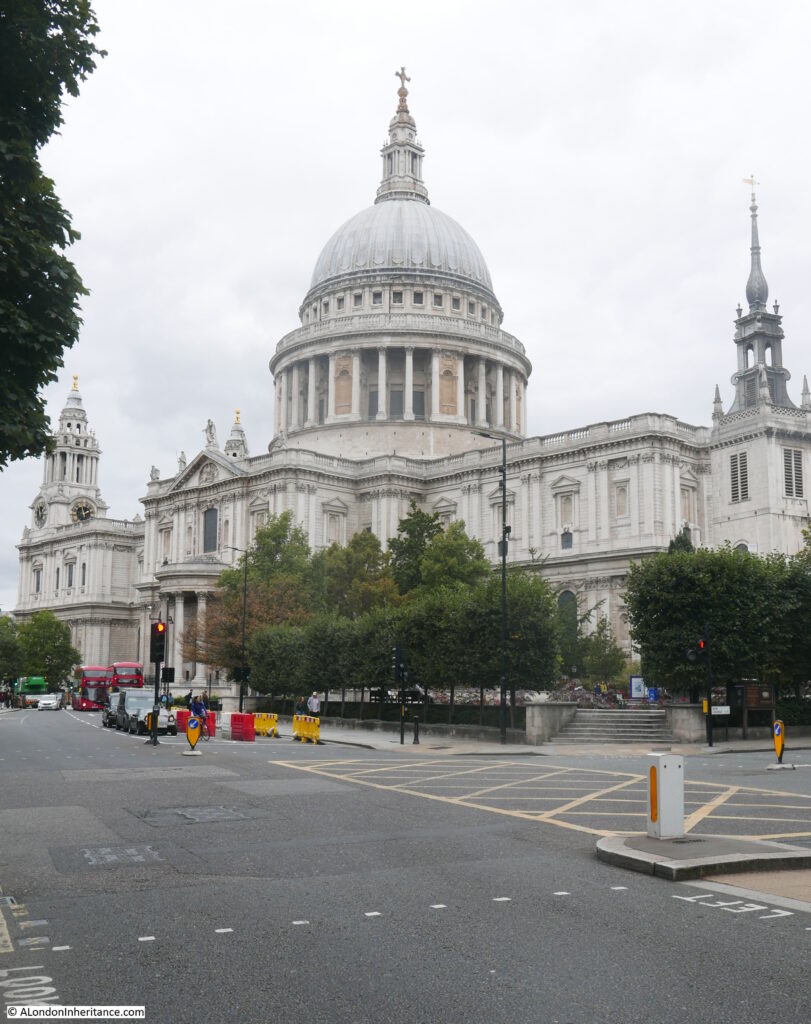
St Paul’s Cathedral has had a number of extensive cleaning and restoration projects over the years, however the state of the cathedral in 1977 was probably not what those who worked on the mid 1960s cleaning project would have expected.
At the end of the 1960s cleaning, it was expected that with recent clean air legislation, and the City of London being designated a smokeless zone the cathedral would remain clean and there was a possibility that in “250 years time, St Paul’s Cathedral will look as Sir Christopher Wren would have liked to have seen it”.
The above quote and the following still is from a fascinating BBC programme from 1965, when “Tonight” had a lengthy feature on the cleaning of St Paul’s Cathedral. The full programme can be watched here, and also highlights the 1960s approach to health and safety (as illustrated in the still below) as well as the rather basic method of cleaning employed. At times the wind lifted the sheets preventing cleaning water from falling to the streets, resulting in some very annoyed City Police Officers who threatened those cleaning the cathedral with a summons if they did not stop work as water was blowing as far as Cannon Street.

There is also a 1962 British Pathe film of the 1960s cleaning project here, which shows how jets of water and wire brushes were used to scrub the soot from the surface of the building, which in some areas was in layers over one inch thick.
Only 11 years after completion of the mid 1960s clean, the cathedral was again looking rather dirty.
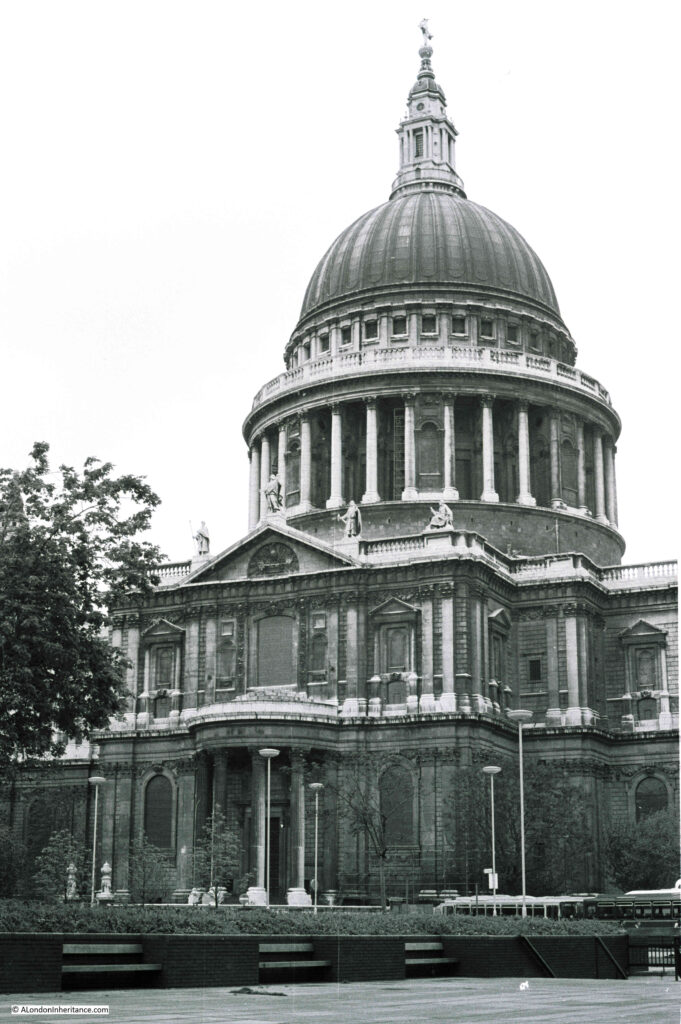
The above photo is the south facing side of the cathedral in 1977 and the photo below is the same view in 2021:
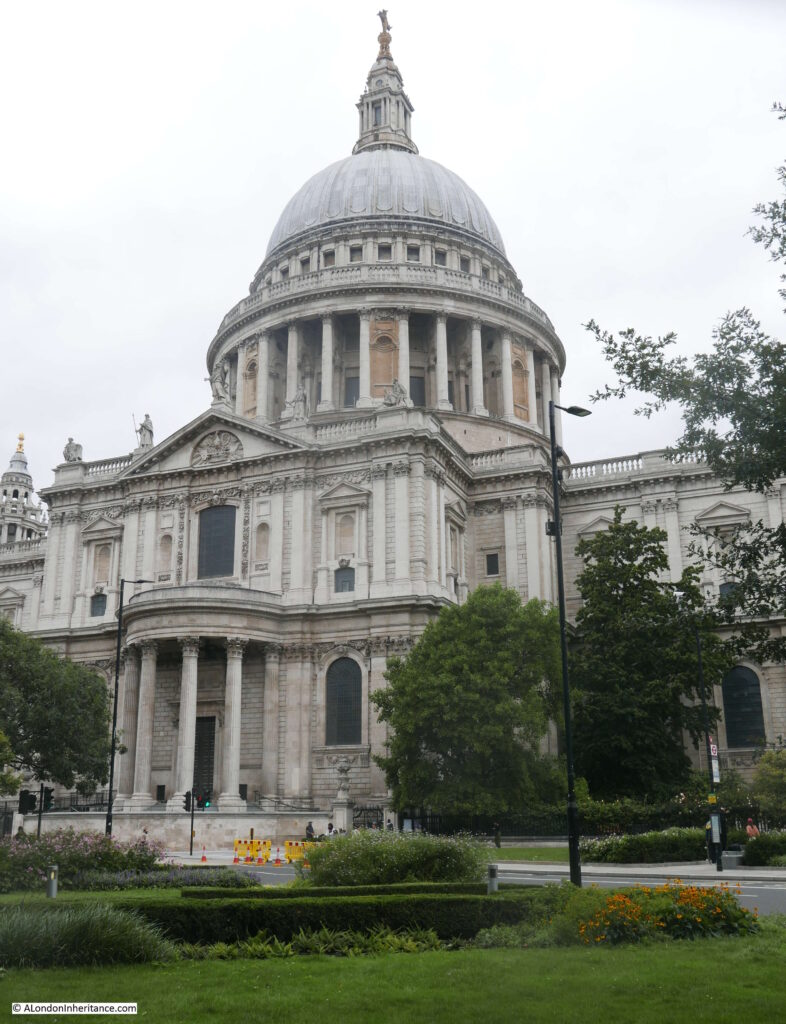
In my 1977 photos, the cathedral appears cleaner towards the top, and dirtier towards the bottom of the building. Although central London was a much cleaner place than it had been for many centuries, vehicles were emitting far more pollutants than they do now, and pollution would still be blowing in from the surrounding area.
It is hard to appreciate just how dirty London was up until the late 1960s. Coal burning in homes, offices and factories along with electricity power stations, and industries producing gas from coal all contributed to a significant smog of pollution and dirt.
The 1960s cleaning of the cathedral had to deal with dirt that was over an inch thick in places, and we can get an idea of the impact of this amount of dirt from a Parliamentary question asked on the 06 April 1955 by Mr. George Isaacs, MP for Southwark, when he states that based on measuring equipment installed next to Bankside Power Station, and at the Town Hall in Walworth Road, they found that over a year, the “deposit recorded at that time was the equivalent to 235 tons to the square mile on Bankside and a mile away in Walworth Road the deposit was 60 tons to the square mile”.
In the written question, he states that it is necessary to live in the area to really know what the impact of this level of pollution to everyday life means, which he describes as: “Our people have grit in their eyes and grit in their food; there is grit underfoot and grit in the laundry on washing day. I know that what I say has happened. There are the large blocks of the Peabody Buildings less than 150 yards from the station. The only place there for women to dry their laundry is on the roof. They put their laundry on the roof, and the grit comes down. Father comes home to tea, and mother goes upstairs to take in the washing, and when she comes down father knows all about it because she is not in a good humour if she finds that she has to do her laundry all over again. I can say with some justification that this is a nuisance not only physically but in the way it upsets amenities and family life in the area”.
The following graph shows how the level of pollution in London, measured by Suspended Particulate Matter (measured in micrograms per cubic metre), has changed over time (source: What the history of London’s air pollution can tell us about the future of today’s growing megacities by Hannah Ritchie, using data from Foquet (2011) – Creative Commons BY license):
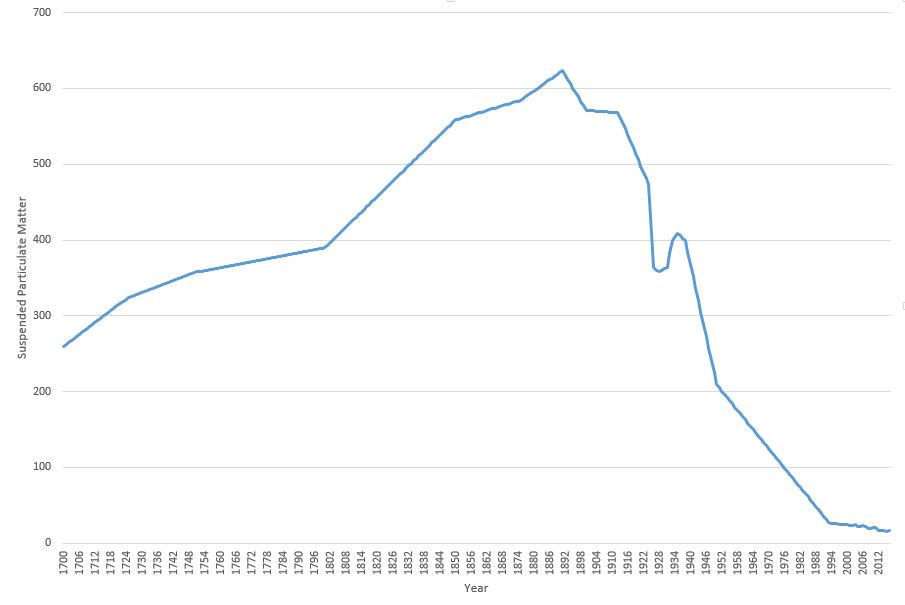
Whether these figures could have been accurately measured going back to 1700 is an interesting question, however the key point of the graph is the overall shape, and the rapid decrease in the second half of the twentieth century, confirming that the air is London is now much cleaner than it has been for many centuries.
The cathedral featured in classroom material produced by the National Society for Clean Air. A chart was produced which included a before and after the recent cleaning view of St Paul’s Cathedral. The chart also included a picture of a boy and girl in clean country air, as well as devices such as smokeless domestic heating equipment. Rather scarily, the chart also included drawings of the sections of the lungs of those living in the city and in the countryside, showing the damage that was being done to the lungs of city dwellers.
School education continues, with the Mayor of London now producing toolkits for schools focusing on air pollution and the dangers of high levels of Nitrogen Dioxide, which particularly affects children, and those with breathing difficulties.
Whilst the clogging grit and smoke that quickly blackened London’s buildings may no longer be a problem, invisible gases such as Nitrogen Dioxide, and very small particulate matter are now the main problem.
Another view of the south facing side of the cathedral in 1977:
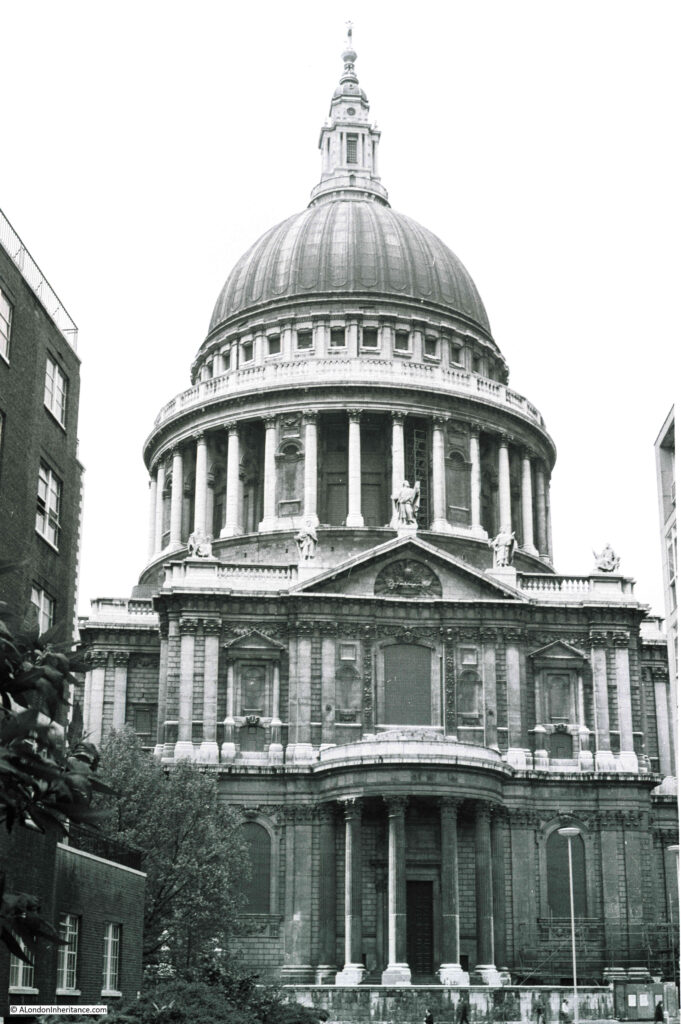
The same view today of a much cleaner building:

The most recent full clean of St Paul’s Cathedral completed in 2011 ready for the 300th anniversary of the cathedral.
This had been a 14 year project which cleaned both the interior and exterior of the building. There were some controversial methods used to clean the cathedral, including a latex paste that was applied to the interior stone, which absorbed the layer of dirt and allowed this to be pulled away with the latex layer.
New methods have frequently been used for cleaning the building. In 1903, an American method of stone cleaning where a blast of pitsand was blown at the cathedral walls through a tube at a pressure of 30lb to the square inch, to try and remove the soot and dirt that was ingrained on the Portland stone of the building.
The main west facing entrance to the cathedral in 1977, photographed from Ludgate Hill.
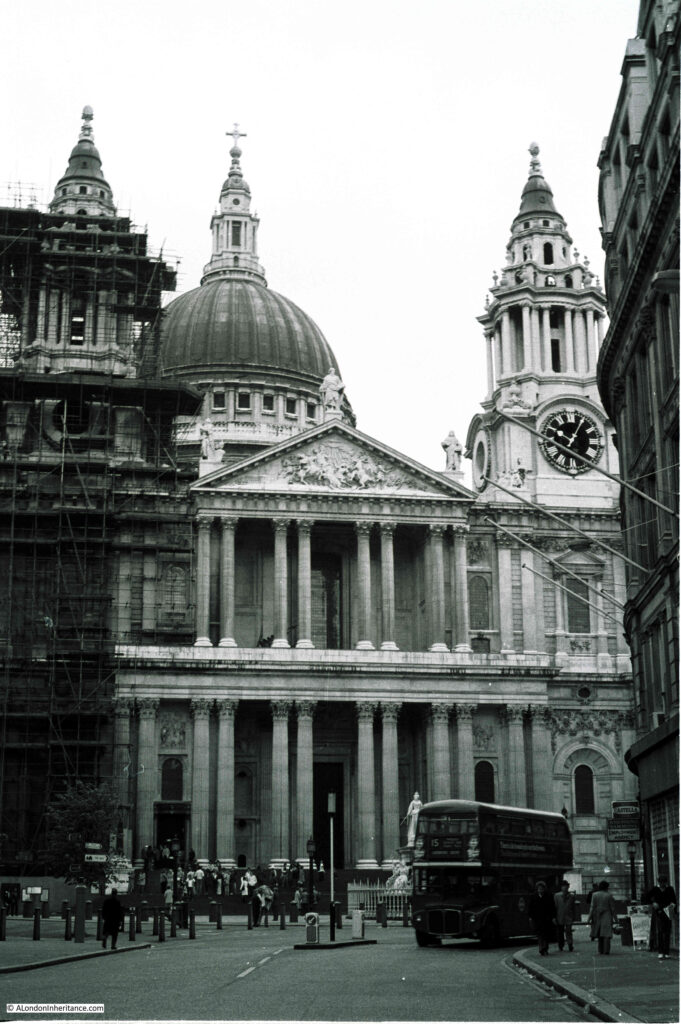
The same view today:
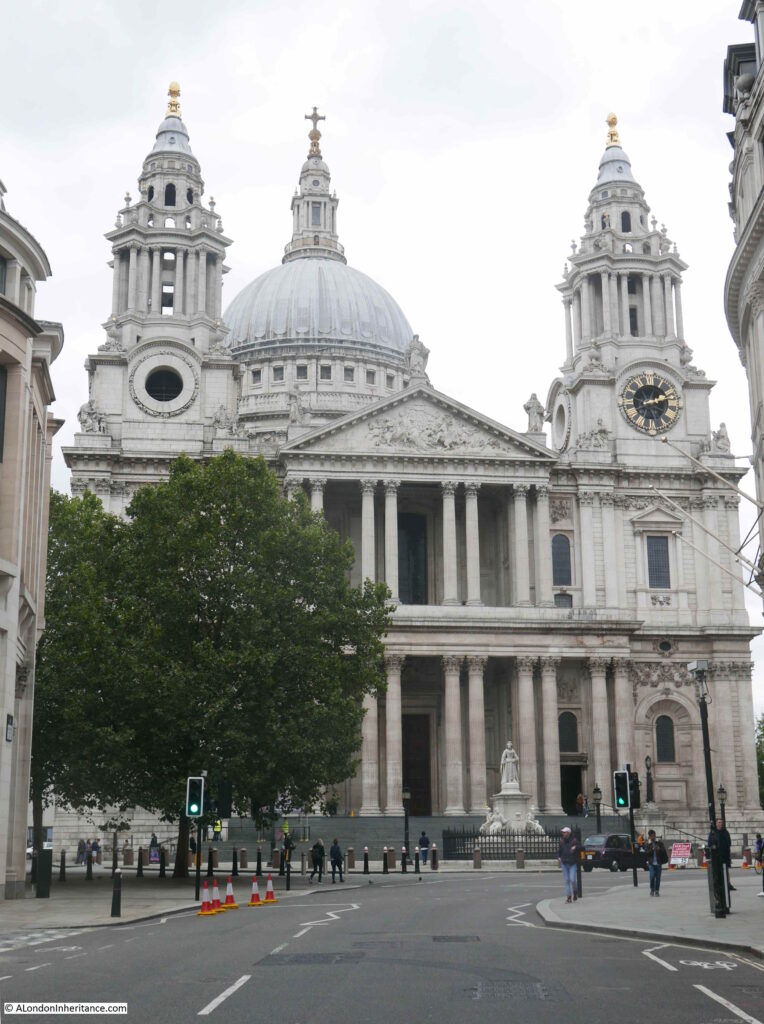
My early memories of walking through the City are of a grey and dirty place, although it is also difficult to be sure how real some of these memories are. What is certain is that the buildings of the City are now much cleaner. The air in many places is better, but there are still many places where pollution levels are too high, generally close to busy roads as London today does not have the same polluting industries as it did.
Hopefully George Isaacs, MP for Southwark would be happy with the change, as well as Sir Christopher Wren who would now recognise the cathedral as it was when it was built.

In some of these clips you can see my Family, Dad, Uncles (Uncle Harry interviewed in the BBC clip – Szerelmeys had the cleaning contract in the 1960s) and Grandad and we put footage up on Youtube (with permission from St Pauls) that Dad was given for helping with information, at the start of the last clean. Dad worked on cleans, for St Paul’s on three occasions (for long durations) from the 60s and had a few stories! Dad was a keen amateur photographer and took pictures for the Evening Standard photographer (as he was afraid of heights and couldn’t go up the scaffolding which is nothing like the elaborate rigging of today), so Dad’s photos made the press!
I left home to live in London in June 1977 (how time has flown) and this is exactly how I remember St Paul’s, which was just round the corner from where I lived. I am always a bit stunned when, these days, I walk past the cathedral and see it so bright and clean. Amazing how small the vehicles seem in these images.
Your photos brought back so many memories. In 1977, I used to work as a commodity graph compiler on St Andrew’s Hill – I had to draw charts using a Rotring pen to make tiny crosses on graph paper using the figures taken from the Financial Times. My office was opposite the print works for the Sunday Observer magazine and the printers would bring free copies during the week but without the adverts. Every Friday, I had to walk up to the Bank of Hong Kong on Threadneedle Street to get a print out of the weekly stock market prices – no computers back then. I would dawdle on the way back and go into St Pauls just to pass a peaceful 10 minutes before going back into the office – and yes, it was very grimy!
That’s a nice vignette of how technology and work has changed in the City.
I have to admire the bravery of the operative on the scaffolding in your third photo. Health and Safety would have closed the site down today !!
Your last two photographs do show how big the tree has grown in a relative short period in time.
I was once taken to a pub near St Paul’s around 30 years ago. It had sawdust on the floor. Can anyone suggest the name of the pub, does it still exist?
Ye Olde Cheshire Cheese on Fleet Street?
As ever, this is a fascinating piece and I thank you for it.
I’m a inner London South Londoner born and bred, but my father is from inner North London, and my mother is Dutch. I remember my paternal grandmother often telling us how she couldn’t see her hand in front of her face in the days of the smog. In contrast, even by the time my mum met and married my dad in Holland and then moved here in the seventies she was amazed that London was not the grim, dirty place she’d seen in fifties’ films.
However, there is still much to be done – thousands of people still die every year in this country due to pollution. The level varies depending on area, of course. I’m from the Crystal Palace/West Norwood/West Dulwich corner of SE London and have lived round here all my life. Ive seen historic advertising posters extolling the clean air here as we are the highest area in SE London. Tellingly, we can easily go years without having to clean our windows. However, I lived for a year on Rodney Rd in Elephant and Castle and there we could barely see out the windows only a few months after having them washed.
Similarly, as a teenager I worked briefly in a shop on Kensington Church Street. Every day I had to clean the products because they were thick with gritty, back dust from the traffic outside.
Most interesting. The particulate graph shows a topping out late 19th century and a then a great decline but one can see the great depression in the rapid drop around 1930 and the economic recovery just before WW2. The idea of putting power plants in the center of London was just nuts but then that’s 20×20 hindsight isn’t it.
When I was a child in the ‘50s my mother would take me occasionally on the Central Line to my father’s office in Lincoln’s Inn Fields, and we would both dress up for the occasion. The challenge was to get there without getting my white socks dirty, but crossing the bridge to get to the platform would always result in black marks down my ankles. Everything in London was black then, apart from a few window boxes. Cars were all black, and there was little colour in mens’ clothing. My father’s collar would have a black rim round it by the time he got home each day.
Autumn always brought the fog, and long waits for the bus home from school. It was great comfort to clamber onto a red number 20 bus with its cosy yellowish lighting. Even on the edge of Epping Forest we sometimes had fog so thick you could not see the traffic on the opposite side of the road. But when people say you could not see your hand in front of your face, I always wonder whether they literally mean it.
My mum, born 1924, lived in Islington and remembers the fogs, and this was before there were many cars on the road:
I remember a few pea-souper fogs. One day Mum and I went to the pictures. It was 6d, sit anywhere, in the afternoon, and when we came out you couldn’t see a thing. There were flares at big road junctions, and of course the trams could proceed slowly as they were on rails. It took us ages to get home as we kept finding ourselves lost, having crossed roads without being aware of it. Once safely indoors I remember being terribly sick from all those poisonous fumes. In those days, of course, everyone had coal fires and the smoke couldn’t escape through the fog layer above.
When I came to live in London in 1954, all the buildings in the centre appeared to be black and I had no idea that they had ever been white. I thought they were built of black stone!
Brings back memories. When I was a student I had a summer job at St Paul’s working on the gift stalls which then were in the side aisles. I often ate my lunch with some of the student vergers working there outside the dome, great views of London!
I worked for the GPO/BT/BTI in what was faraday bulding from early 70’s to mid 80’s. Used to drink in the The BEll, the Horms and Barnard Castle. I used to love it around there.
Very iconic building my favourite
They should paint the dirt back on, It looked much more interesting with the pattern of antiquity from its interesting life – the ravages of Victorian smog, and war, all washed away..
There’d be nothing remaining if you left the dirt / clinker on, as the acid produced from this material and rain would eat the building from the outside in, goes for bird droppings too! Cleaning often highlights areas of structural repair need too. Some buildings interestingly were ‘whitewashed’ to give them a white gleam that was far brighter than the new / actual stone and my Dad was called to a building in Kensington High Street, to consult with English Heritage regarding this. The ‘consultant’ insisted that the building be cleaned to a white that the building showed on a recently uncovered area. Dad said it was not possible and the consultant queried how his knowledge was more than the consultant’s. Dad told him that he’d worked on the building during the last clean and that the area had been ‘whitewashed’ and that the original stone was grey! Dad then licked his finger, ran it along the whilte wash and demonstrated that you could, with some abbrasion, removing the coating!! Building was left in the original pale grey stone.
Ian Nairn would have agreed with you that the building was more interesting – and had more character and personality – before it was cleaned in the 1960s.
I worked for the GPO and from 1969 to 1990 I worked in and around St Pauls, in various telephone exchanges including Faraday Biulding, Wren House, Mondial House, Wood Street. The picture of what was the AA resturant on the corner of Carter Lane brought back memories of Mick the manager, Gert the old indian lady who served the teas and coffees. Also the City Grill with Mario, George and their wives. I used to drink in the Bell, The Horns, the Christoher Wren to name but a few.
Happy days